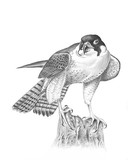08 March, 2006
- Christina Langman
- 8,359 Views
- 51 Comments
Scratchboard & Acrylic Tutorial
Ok, so here's the long awaited tutorial... on how to do scratchboard/acrylic combination art.
This is another ATC/ACEO - so it is only 2.5 x 3.5, a very tiny piece of art! I had a lot of fun doing this picture though, and I think it turned out great.
I hope you enjoy the tutorial!

